

| An atlas of Nottinghamshire Ladybirds |
| An Atlas of Nottinghamshire Ladybirds pdf file |
| ... |
| Ladybirds include some of our most
popular and easily recognised beetles. Their often bright, spotted
elytra colouration makes them immediate favourites with children, but
most adults also have a fondness for Ladybirds, no doubt producing happy
memories of their own childhood. Many of our more common species, quickly become familiar to people from a very early age. As a consequence, they are often well recorded and our knowledge of Ladybird distribution in Nottinghamshire, is very good compared to the majority of beetles. This Atlas of Nottinghamshire Ladybirds produces up to date distribution maps of all the Coccinellidae (Ladybirds) recorded in the county over recent years. No Atlas can ever be complete, but this work is as comprehensive as is possible for us to do at the present time and is regularly updated when at all possible. |
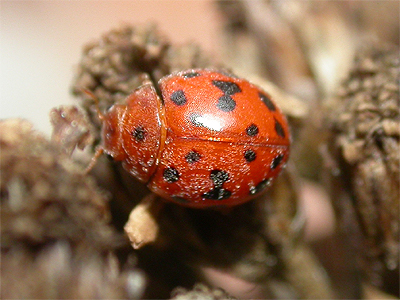 |
|
| .... | ||
| Nottinghamshire species and the introduced Cryptolaemus montrouzieri | ||
| .... | ||
 |
Nottinghamshire currently
has a total of 35 species, of which 22 of these would be
easily recognisable by the majority of the public as
being typical Ladybirds. This Atlas does not include Cryptolaemus
montrouzieri (Mulsant, 1853) as this beetle does not occur
naturally in Nottinghamshire, but can be found quite
easily, in the tropical house at Woodthorpe Grange in
Nottingham. C. montrouzieri is an introduced species and is commonly used as a biological pest control of Mealybugs by many commercial growers in large glasshouses. Adults occasionally escape through ventilation windows, where they may be found outdoors for a time, but they cannot survive the UK Winter. The Coccidula, Rhyzobius, Scymnus and Nephus species, are usually very small, rarely found unless specifically searched for and often difficult to identify without resorting to genitalia dissection. They are also less well recorded in the county, than the easily recognisable Ladybirds most people will be much more familiar with. |
|
| .... | ||
| Some recent
Nottinghamshire additions Despite lockdown measures and the restrictions of public movement brought about by the Covid-19 pandemic, coleopterists have recently recorded three more new species for VC56 Nottinghamshire. On April 22nd 2020, Adrian Dutton swept Clitostethus arcuatus (Rossi, 1794) from a field edge at Stoke Farm, Stoke Bardolph. Typically found on Ivy, Adrian was surprised at the find and location, but there was plenty of Ivy close by. Although the NBN Atlas lists an historical record from Harby in north-east Nottinghamshire (NBGRC), the record is rather vague, apparently being a preserved specimen, with no given collector/recorder or determiner and a grid reference of SK8770. The NBN does list the record as being 'unconfirmed' and if it is indeed historical, J.W. Carr makes no mention of it in his 1916 publication. It is most likely that Adrian's Stoke Bardolph record, is indeed the first confirmed Nottinghamshire record. In early May and little more than a fortnight after the above record, Tim Sexton was just as surprised when beating an Ivy covered tree in his Attenborough garden and finding Nephus quadrimaculatus (Herbst, 1783). A check with the NBN Atlas showed no records for VC56, but it had been recorded in the county previously, when found at Tollerton by Gary Golding in 2019. In January 2019, Rhyzobius lophanthae was also added new to the county list of Coccinellidae, when a single specimen was beaten from Box (Buxus sempervirens) growing in Lambley Cemetery. Another tiny species, Rhyzobius lophanthae is originally of Australian origin but with a number of records across much of the south of the country. Scymnus interruptus turned up in a Market Warsop garden in July 2023, while Scymnus auritus turned up at Clumber Park in May 2025. |
||
| A checklist of Nottinghamshire Coccinellidae |
| .... |
| COCCIDULA Kugelann in Illiger, 1798 |
| Coccidula rufa (Herbst, 1783) |
| Coccidula scutellata (Herbst, 1783) |
| .... |
| STETHORUS KWeise, 1885 |
|
Stethorus pusillus (Herbst, 1797 |
| RHYZOBIUS Stephens, 1829 |
| Rhyzobius chrysomeloides (Herbst, 1792) |
|
Rhyzobius forestieri (Mulsant, 1853) |
| Rhyzobius litura (Fabricius, 1787) |
| Rhyzobius lophanthae (Blaisdell, 1892) |
| .... |
| CLITOSTETHUS Weise, 1885 |
| Clitostethus arcuatus (Rossi, 1794) |
| SCYMNUS Kugelann, 1794 |
| Scymnus auritus (Thunberg, 1795) |
| Scymnus frontalis (Fabricius, 1787) |
| Scymnus haemorrhoidalis (Herbst, 1797) |
| Scymnus interruptus (Goeze, 1777) |
|
Scymnus nigrinus (Kugelann, 1794) |
| Scymnus schmidti (Fürsch, 1958) |
| Scymnus suturalis (Thunberg, 1795) |
| .... |
| NEPHUS Mulsant, 1846 |
| Nephus quadrimaculatus (Herbst, 1783) |
| Nephus redtenbacheri (Mulsant, 1846) |
| .... |
| CRYPTOLAEMUS Mulsant, 1853 |
| Cryptolaemus montrouzieri (Mulsant, 1853) |
| .... |
| CHILOCORUS Leach, 1815 |
| Chilocorus bipustulatus Heather Ladybird (Linnaeus, 1758) |
| Chilocorus renipustulatus Kidney-spot Ladybird (Scriba, 1791) |
| .... |
| EXOCHOMUS Redtenbacher, 1843 |
| Exochomus quadripustulatus Pine Ladybird (Linnaeus, 1758) |
| .... |
| ANISOSTICTA Dejean, 1836 |
| Anisosticta novemdecimpunctata Water Ladybird (Linnaeus, 1758) |
| .... |
| TYTTHASPIS Crotch, 1874 |
| Tytthaspis sedecimguttata 16-spot Ladybird (Linnaeus, 1758) |
| .... |
| MYZIA Mulsant, 1846 |
| Myzia oblongoguttata Striped Ladybird (Linnaeus, 1758) |
| .... |
| MYRRHA Mulsant, 1846 |
| Myrrha octodecimguttata 18-spot Ladybird (Linnaeus, 1758) |
| .... |
| PROPYLEA Mulsant, 1846 |
| Propylea quattuordecimpunctata 14-spot Ladybird (Linnaeus, 1758) |
| .... |
| CALVIA Mulsant, 1846 |
| Calvia quattuordecimguttata Cream-Spot Ladybird (Linnaeus, 1758) |
| .... |
| HALYZIA Mulsant, 1846 |
| Halyzia sedecimguttata Orange Ladybird (Linnaeus, 1758) |
| .... |
| PSYLLOBORA Dejean, 1836 |
| Psyllobora vigintiduopunctata 22-spot Ladybird (Linnaeus, 1758) |
| .... |
| ANATIS Mulsant, 1846 |
| Anatis ocellata Eyed Ladybird (Linnaeus, 1758) |
| .... |
| APHIDECTA Weise, 1899 |
| Aphidecta obliterata Larch Ladybird (Linnaeus, 1758) |
| .... |
| HIPPODAMIA Dejean, 1836 |
| Hippodamia variegata Adonis Ladybird (Goeze, 1777) |
| .... |
| COCCINELLA Linnaeus, 1758 |
| Coccinella hieroglyphica Hieroglyphic Ladybird (Linnaeus, 1758) |
| Coccinella septempuctata 7-spot Ladybird (Linnaeus, 1758) |
| Coccinella undecimpunctata 11-spot Ladybird (Linnaeus, 1758) |
| .... |
| ADALIA Mulsant, 1846 |
| Adalia bipunctata 2-spot Ladybird (Linnaeus, 1758) |
| Adalia decempunctata 10-spot Ladybird (Linnaeus, 1758) |
| .... |
| HARMONIA Mulsant, 1846 |
| Harmonia axyridis Harlequin Ladybird (Pallas, 1773) |
| Harmonia quadripunctata Cream-streaked Ladybird (Pontoppidan, 1763) |
| .... |
| SUBCOCCINELLA Guérin-Méneville, 1844 |
| Subcoccinella vigintiquattuorpunctata 24-spot Ladybird (Linnaeus, 1758) |
| The
Nottinghamshire distribution maps The following distribution maps are sourced from the records of the following list of individuals and organisations/survey results and are as accurate as can be (as of January 2022) with the records and data we have at our disposal. We have also refrained from using historical records listed in J.W. Carrs book 'The Invertebrate Fauna of Nottinghamshire' published in 1916. Nottinghamshire Wildlife Trust, Keith Alexander (Invertebrate assemblage condition at Birklands & Bilhaugh SSSI/Birklands West & Ollerton Corner SSSI surveys 2009-10) Pauline Bradford, Netherfield Wildlife Group, M L Denton (2002 Sherwood Forest Coleoptera survey data) Martin Harvey, Wil Heeney, Bob Merritt, Natural England (Invertebrate Site Register - Sherwood Forest NNR Coleoptera records, 2006) Trevor and Dilys Pendleton, Richard Rogers and the Sherwood Forest Trust (2008 Oak Tree Heath Coleoptera survey data) |
||
| COLEOPTERA - CUCUJOIDEA - COCCINELLIDAE - COCCIDULINAE - Coccidula | COLEOPTERA - CUCUJOIDEA - COCCINELLIDAE - COCCIDULINAE - Coccidula | |
| Coccidula rufa | Coccidula scutellata | |
| Nottinghamshire distribution: Has continued to prove to be pretty widespread in wetland areas across many parts of Nottinghamshire, although it could still be regarded as being a somewhat under recorded species. Usually found close water, on the leaves of Bulrush. Over-wintering is known to take place within dead Bulrush stems. | Nottinghamshire distribution: Considerably less common than the preceding species, yet possibly under recorded to a certain degree. There have been two further records since records from Moorbridge Pond in 2001 (Kirby, P.) and Eakring Flash in 2013 (Pendleton, T.A. and Pendleton, D.T.), Langford Lowfields in 2015 (Barnes, C.) and Warsop Main Pit Top in 2020 (Pendleton, T.A). Found in similar habitat to Coccidula rufa and over-wintering the same. Probably best looked for within the stems of Bulrush during the winter. | |
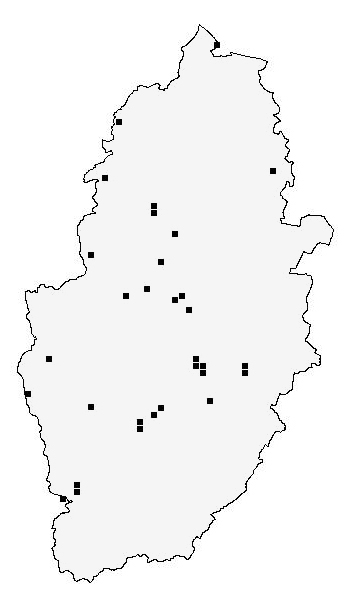 |
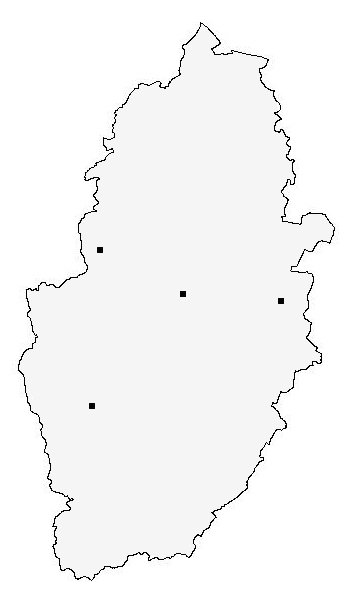 |
|
| .................................................................................................... | ||
| COLEOPTERA - CUCUJOIDEA - COCCINELLIDAE - COCCIDULINAE - Rhyzobius | COLEOPTERA - CUCUJOIDEA - COCCINELLIDAE - COCCIDULINAE - Rhyzobius | |
| Rhyzobius chrysomeloides | Rhyzobius forestieri | |
| Nottinghamshire distribution: Recorded as being new to Nottinghamshire in 2013, when found at Stapleford by Steve Lane. It was recorded at Carlton in 2015 by Adrian Dutton and four years later in 2019, it was recorded at Holme Pierrepont (Golding, G.). The most recent record seems to be from Lambley Cemetery in 2020, where a number of adults were beaten from Box (Buxus sempervirens) and Ivy (Hedera helix). | Nottinghamshire distribution: Another tiny Coccinellid which has spread northwards from the London area and appears to have arrived in Nottinghamshire sometime within the last few years. To date, there is believed to be just a single county record, when beaten off a mature Chamaecyparis leylandii hedge on Meadow Lane, Attenborough by Sean Browne and Nigel Slater. Rhyzobius forestieri is found on a range of evergreen shrubs (including Ivy) often in parks and gardens. Its very small size does make it slightly less than obvious from our more familiar ladybirds. | |
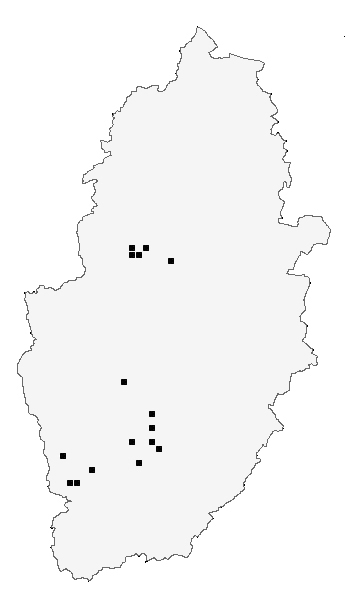 |
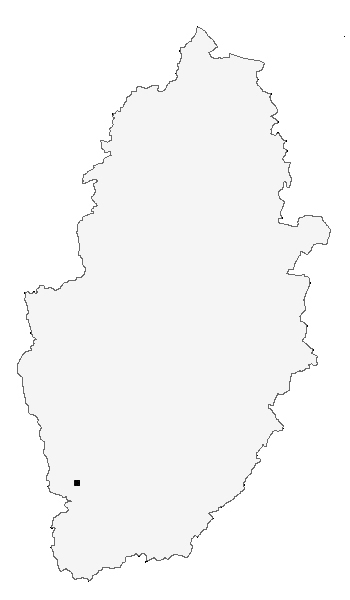 |
|
| COLEOPTERA - CUCUJOIDEA - COCCINELLIDAE - COCCIDULINAE - Rhyzobius | COLEOPTERA - CUCUJOIDEA - COCCINELLIDAE - COCCIDULINAE - Rhyzobius | |
| Rhyzobius litura | Rhyzobius lophanthae | |
| Nottinghamshire distribution: Widespread and quite common across most of Nottinghamshire, but there are few records from sites east of the River Trent, although it occurs quite widely along the Trent Valley. A small species, best looked for by sweeping areas of lush vegetation. | Nottinghamshire
distribution:
Originally of Australian origin,
with a number of records across much of the south of the country. The
first Nottinghamshire record was beaten from Buxus sempervirens
growing at Lambley Cemetery
in early January 2019 (Pendleton, T.A. and Pendleton, D.T.). It has since been recorded from Chamaecyparis leylandii hedgeS adjacent to Lambley Cemetery (September 2021), from Ruddington CP in March 2021 (Slater, N.) and at Meadow Lane, Attenborough (Slater, N. and Browne, S.) in August 2021. |
|
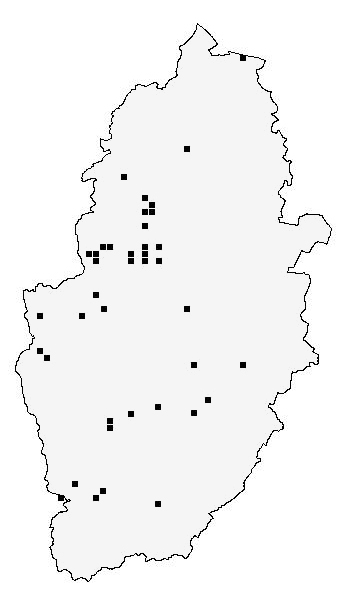 |
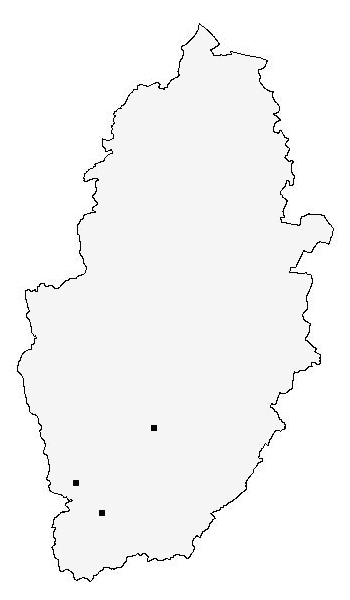 |
|
| COLEOPTERA - CUCUJOIDEA - COCCINELLIDAE - COCCIDULINAE - Stethorus | COLEOPTERA - CUCUJOIDEA - COCCINELLIDAE - COCCIDULINAE - Clytostethus | |
| Stethorus pusillus | Clitostethus arcuatus | |
| Nottinghamshire
distribution:
Recorded
by Nigel Slater as new to
Nottinghamshire
from
Meadow Lane, Attenborough on 14/08/21
and which remained the county's only known record to date until another
was recorded during an invertebrate survey of Lambley's Trinity Church
in 2023.
This species is found widely over much of the south-east UK and across into the West Midlands. |
Nottinghamshire
distribution:
Recorded new to Nottinghamshire on April 22nd 2020,
when Adrian Dutton swept a single
Clitostethus arcuatus
(Rossi, 1794) from a field edge at Stoke Farm, Stoke Bardolph. Typically
found on Ivy, Adrian was surprised at the find and location, but there
was plenty of Ivy close by.
And there has recently been a
second county record, when four were beaten off Ivy at Kirton Wood in
late April 2025 by Nick and Samantha Brownley. Although the NBN Atlas lists an historical record from Harby in north-east Nottinghamshire, the record is rather vague, apparently being a preserved specimen, with no given collector/recorder, or determiner and a grid reference of SK8770, yet J.W. Carr makes no mention of it in his 1916 publication. |
|
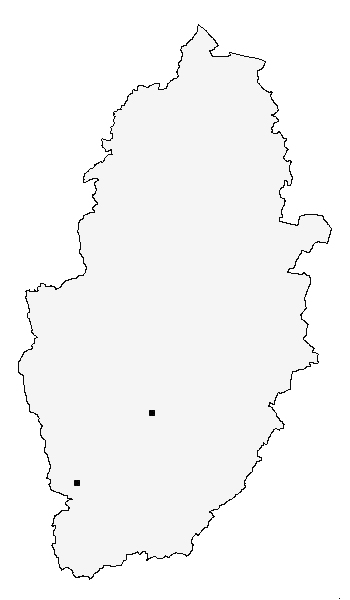 |
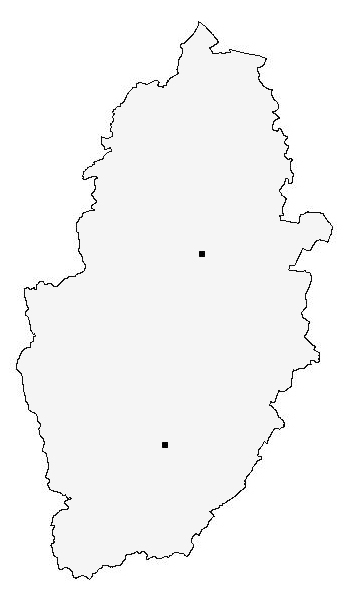 |
|
| COLEOPTERA - CUCUJOIDEA - COCCINELLIDAE - COCCIDULINAE - Scymnus | COLEOPTERA - CUCUJOIDEA - COCCINELLIDAE - COCCIDULINAE - Scymnus | |
| Scymnus auritus | Scymnus frontalis | |
| Nottinghamshire distribution: This seems to be a rare ladybird in Nottinghamshire and there appears to be no previous records on the NBN Atlas. This may well be the county's first record of what is another very small species. It was beaten off Oak at Clumber Park in May 2025, by Nick and Samantha Brownley, who kindly provided me with the specimen to for inclusion here. | Nottinghamshire distribution: Still scarce with four Nottinghamshire records to date. Singles turned up during invertebrate surveys at Sherwood Heath in 2006 (Godfrey, A.) and Bentinck Banks NR in 2007 (Kirby, P.). Following a gap of several years, there were records from a brownfield site at Langar in 2014, a field-edge near Broomhill Grange in 2015 (Pendleton, T.A. and Pendleton, D.T.) and from Rainworth Heath in 2021 (Pendleton, T.A.). | |
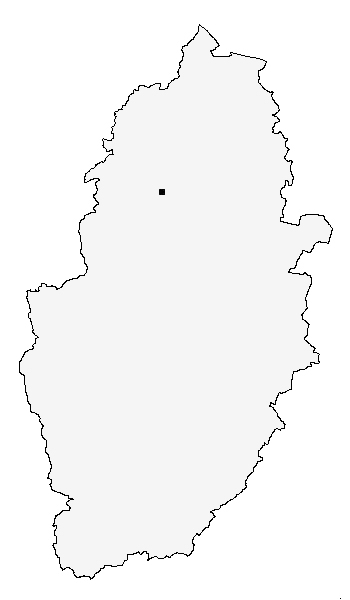 |
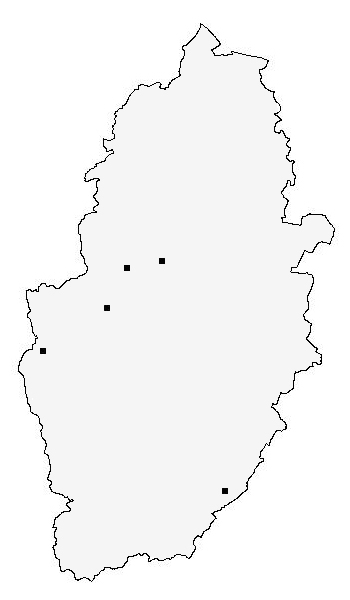 |
|
| COLEOPTERA - CUCUJOIDEA - COCCINELLIDAE - COCCIDULINAE - Scymnus | COLEOPTERA - CUCUJOIDEA - COCCINELLIDAE - COCCIDULINAE - Scymnus | |
| Scymnus haemorrhoidalis | Scymnus interruptus | |
| Nottinghamshire
distribution:
There
are seven records from seven very widespread
sites across the county,
which includes
a brownfield site in the centre of Nottingham.
Most of Nottinghamshire’s records have both come from sites east of a line running down through the middle of the county, with records from Treswell Wood and Farndon Willow Holt in 2003 (Kirby, P.), Sherwood Heath in 2003 (Godfrey, A.), Colwick CP, Nottingham Trent University’s Brackenhurst Campus and Nottingham City centre in 2016 (Heeney, W.) and more recently from the site of the former Bilsthorpe Colliery in 2017 (Pendleton, T.A. and Pendleton, D.T.). |
Nottinghamshire
distribution: The occurrence of this small ladybird on a large
Ceonothus growing in a Market Warsop garden in July 2023, seems
to represent the first record for Nottinghamshire. Uusally found in gardens across much of south-eastern part of the UK, it appreas to be spreading north and the Market Warsop record is one of the most northerly. It favours a variety of evergreen shrubs and Ivy covered walls etc. |
|
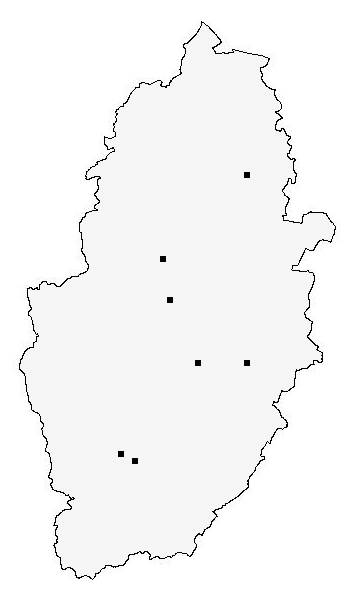 |
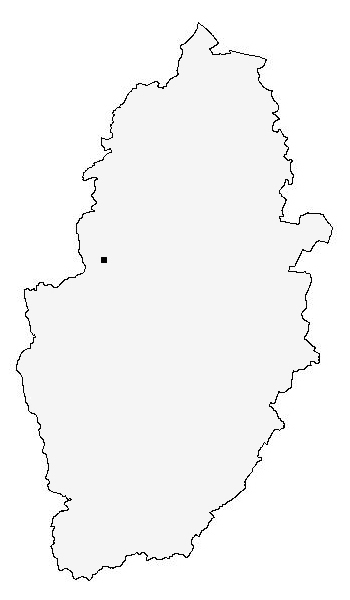 |
|
| COLEOPTERA - CUCUJOIDEA - COCCINELLIDAE - COCCIDULINAE - Scymnus | COLEOPTERA - CUCUJOIDEA - COCCINELLIDAE - COCCIDULINAE - Scymnus | |
| Scymnus nigrinus | Scymnus schmidti | |
| Nottinghamshire distribution: Two records within a few days of each other in August 2021, seem to be the first Nottinghamshire records of Scymnus nigrinus since two historical records listed on the NBN Atlas from as far back as 1816 and 1828, both of which are old records even by historical standards. The one below was found on a small Pine growing on Oak Tree Heath during an invertebrate survey on 10/08/21 (Pendleton, T.A.) and was followed a few days later by three more (also on Pine scrub) found by Sean Browne on Budby South Forest on 13/08/21. | Nottinghamshire distribution: One of three difficult Scymnus species to identify There are just three Nottinghamshire records, all from sites lying on Sherwood Sandstone. It was found during invertebrate surveys at Sherwood Heath near Ollerton in 2006 (Godfrey, A.) at Sherwood Forest CP in 2009 (Alexander, K.N.A.) and then at Rainworth Heath in 2014 (Pendleton, T.A. and Pendleton, D.T.). | |
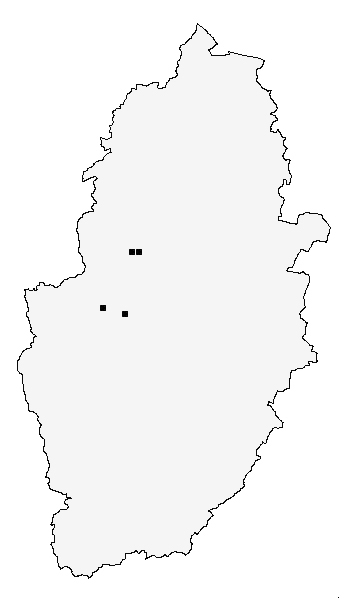 |
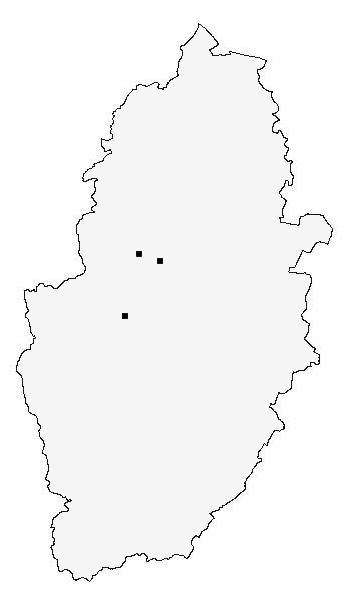 |
|
| COLEOPTERA - CUCUJOIDEA - COCCINELLIDAE - COCCIDULINAE - Scymnus | COLEOPTERA - CUCUJOIDEA - COCCINELLIDAE - COCCIDULINAE - Nephus | |
| Scymnus suturalis |
Nephus quadrimaculatus |
|
| Nottinghamshire distribution: Still a rather uncommon find, although regular use of a beating tray at heathland sites containing Scot’s Pine, should perhaps show it to be more common than is presently supposed? There are still relatively few Nottinghamshire records and as would be expected, most of these are from the Sherwood Forest area, but there are isolated records from Lound Wood at Eakring, Haywood Oaks, Gedling Pit Top (now Gedling CP), Warsop Main Pit Top and from an industrial area in Beeston. | Nottinghamshire distribution: Another very small ladybird which was found new to Nottinghamshire as recently as 2019, when recorded from Tollerton (Golding, G.). The following year, a second county record came from an Attenborough garden on Trent Lane, where a specimen was beaten from an Ivy covered tree in May 2020 (Sexton, T.). Deliberate searching for this species took place in 2021 and further records of Nephus quadrimaculatus came from Meadow Lane in Attenborough and Beeston Sidings. | |
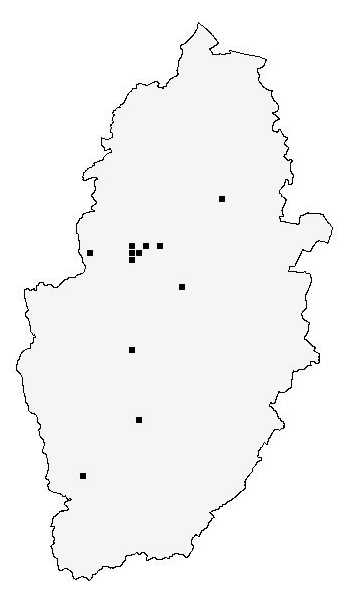 |
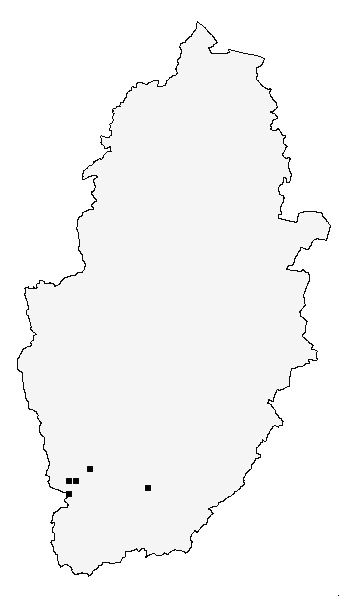 |
|
| COLEOPTERA - CUCUJOIDEA - COCCINELLIDAE - COCCIDULINAE - Nephus | COLEOPTERA - CUCUJOIDEA - COCCINELLIDAE - COCCIDULINAE - Cryptolaemus | |
| Nephus redtenbacheri | Cryptolaemus montrouzieri | |
| Nottinghamshire
distribution:
Despite a number
of additional records being traced since the last
edition of this atlas, Nephus redtenbacheri
still very much remains an uncommon find in the
county. The first atlas produced
just three Nottinghamshire records, from
Grove near Retford in 1999
(Merritt, R.), Treswell Wood in 2003 (Kirby, P.)
and Attenborough NR in 2011 (Richards, D.).
Those additional records include Sherwood Heath in 2006 (Godfrey, A.), Bentinck Banks in 2007 (Kirby, P.) and Clumber Park in 2007 (Godfrey, A.), but the most recent records include Attenborough NR in 2015 (Sexton, T.) and Market Warsop in 2020 (Pendleton, T.A.). |
Nottinghamshire
distribution: An introduced
species found in heated greenhouses. It is commonly used
by commercial growers in large glasshouses as a
biological pest control of Mealybugs. Adults occasionally escape through ventilation windows, where they may be found outdoors for a time, but cannot survive the UK Winter. |
|
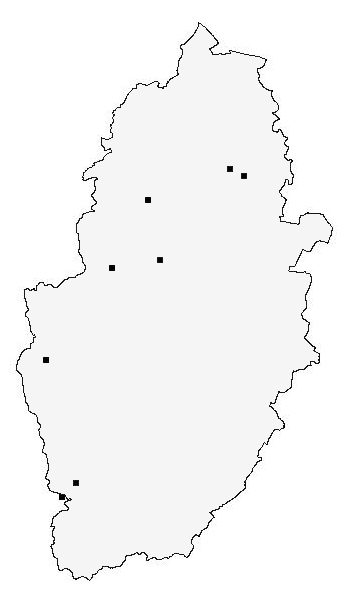 |
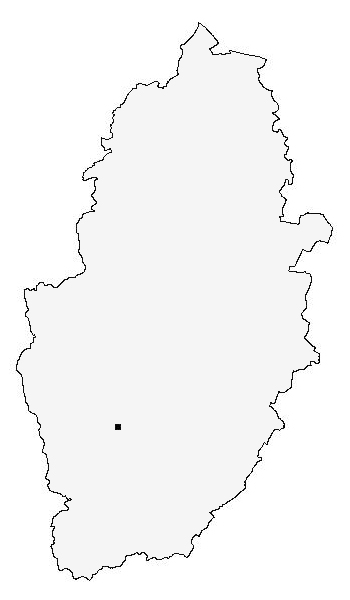 |
|
| COLEOPTERA - CUCUJOIDEA - COCCINELLIDAE - CHILOCORINAE - Chilocorus | COLEOPTERA - CUCUJOIDEA - COCCINELLIDAE - CHILOCORINAE - Chilocorus | |
| Chilocorus bipustulatus | Chilocorus renipustulatus | |
| Nottinghamshire distribution: The Heather Ladybird has a very restricted distribution in Nottinghamshire and is a true heathland species. In Nottinghamshire, this species is largely confined to Budby South Forest, but there are records from Sherwood Heath and a small area of heathland within the Sherwood Forest CP. It doubtless occurs on other small areas of heathland found throughout the Mansfield/Sherwood Forest area, of which a single record from Rainworth Heath is the perfect example. | Nottinghamshire distribution: Widespread and common, although rarely found in numbers at any site. This is an arboreal species found in most open woodlands throughout the county, where the trunks of trees catch plenty of warm sunlight. The Kidney-spot Ladybird is best looked for on the trunks of smooth-barked trees such as Ash Fraxinus excelsior, but it also regularly favours larger examples of Goat Sallow Salix caprea growing close to water. | |
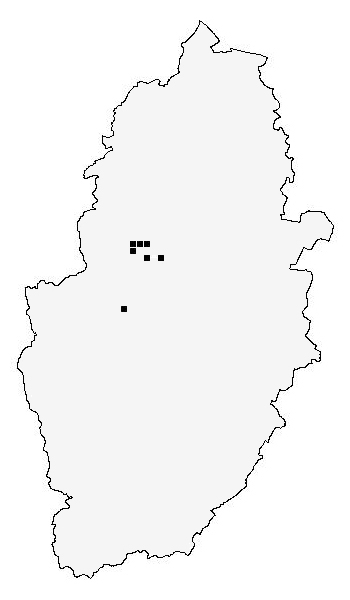 |
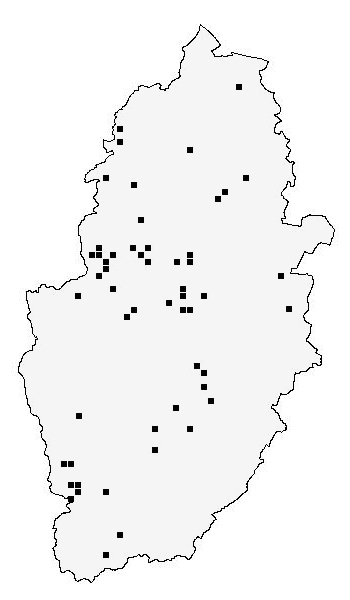 |
|
| COLEOPTERA - CUCUJOIDEA - COCCINELLIDAE - CHILOCORINAE - Exochomus | COLEOPTERA - CUCUJOIDEA - COCCINELLIDAE - COCCINELLINAE - Anisostica | |
| Exochomus quadripustulatus | Anisosticta novemdecimpunctata | |
| Nottinghamshire distribution: Very common and despite being called the Pine Ladybird, this species is just as likely to be found on roadside Limes in the suburbs of Nottingham, as it is in areas of commercial forestry. It does occur in numbers on small Pines growing on many former Colliery sites, often over-wintering at the end of the previous year's growth, but large numbers of post-overwintering individuals have been found on Ivy growing over walls in sunny situations. | Nottinghamshire distribution: The Water Ladybird is widespread in Nottinghamshire. It favours waterside vegetation, particularly Bulrush and passes the Winter inside dead stems, or tucked into the leaves. This Ladybird is well known for losing its light orange colouration in the Autumn before over-wintering, when it becomes straw coloured, although the spots remain. | |
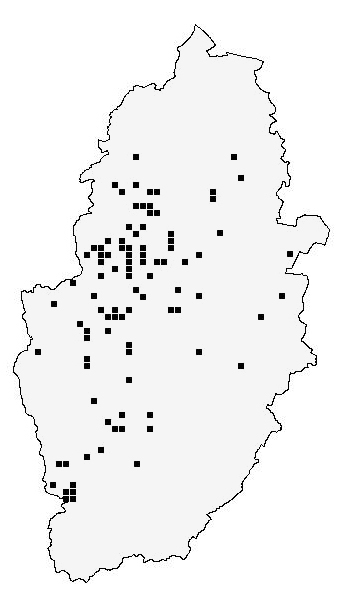 |
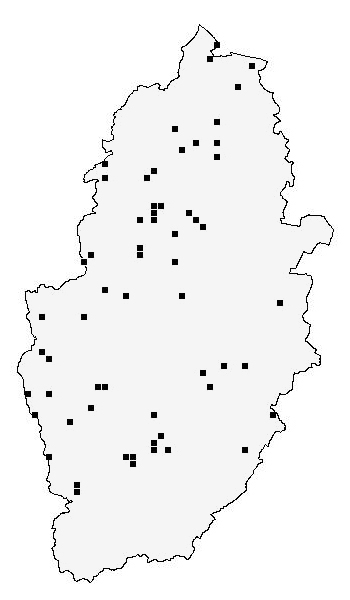 |
|
| .............................................. | ........................................................................................................ | |
| COLEOPTERA - CUCUJOIDEA - COCCINELLIDAE - COCCINELLINAE - Tytthaspis | COLEOPTERA - CUCUJOIDEA - COCCINELLIDAE - COCCINELLINAE - Myzia | |
| Tytthaspis sedecimguttata | Myzia oblongoguttata | |
| Nottinghamshire distribution: Widespread in grassy areas with an abundance of flowers, in the western-half of Nottinghamshire. The 16-spot Ladybird's small size and pale colouration, often leads to it being overlooked. It will frequently turn up in the sweep-net and usually over-winters in grass tussocks and leaf litter. | Nottinghamshire distribution: An arboreal species which is rare and often difficult to find. The distinctively-marked Striped Ladybird prefers areas of Pine and the only records are from Clipstone Forest, Budby South Forest and Clipstone Old Quarter (Pendleton, T.A. and Pendleton, D.T.). It over-winters, probably under the flaked bark of Pines, but sometimes at the end of the previous years growth. | |
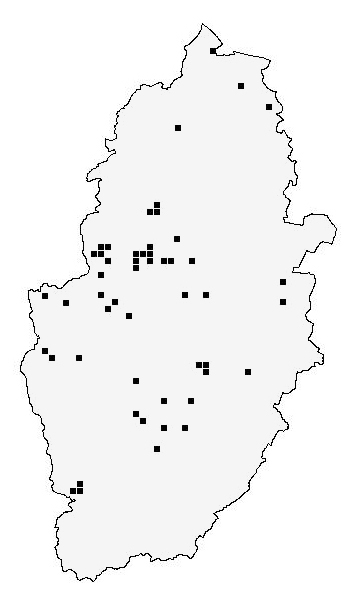 |
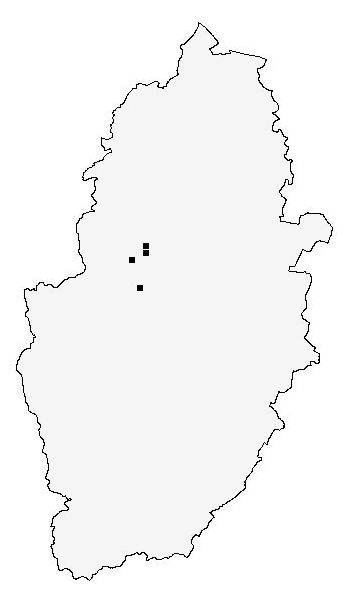 |
|
| COLEOPTERA - CUCUJOIDEA - COCCINELLIDAE - COCCINELLINAE - Myrrha | COLEOPTERA - CUCUJOIDEA - COCCINELLIDAE - COCCINELLINAE - Propylea | |
| Myrrha octodecimguttata | Propylea quattuordecimpunctata | |
| Nottinghamshire distribution: Currently remains scarce/rare with just a handful of records, although it may well be more widespread than the distribution map suggests. 18-spot Ladybird is found on or in the vicinity of Pines, but it is not confined to the large areas of commercial forestry which remain within the Sherwood Forest area. There are records for Budby South Forest, near Haywood Oaks and Mansfield, where it turned up in numbers on an isolated Pine in an open area on the Oak Tree Lane estate. | Nottinghamshire
distribution: The 14-spot Ladybird is one of our
commonest species and found in a range of well vegetated
habitats including gardens, woodland and along hedgerows. It is widespread across Nottinghamshire, although there appear to be fewer records from sites lying east of the River Trent, but this is probably due to the lack of recording from these areas. |
|
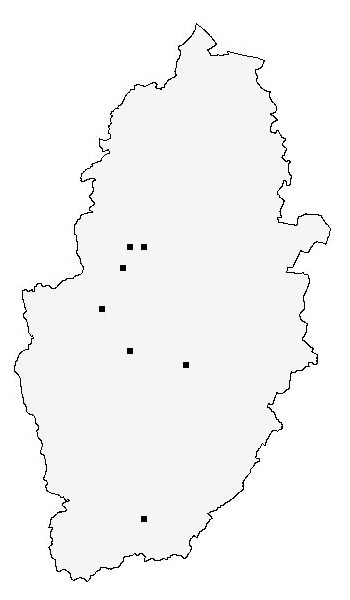 |
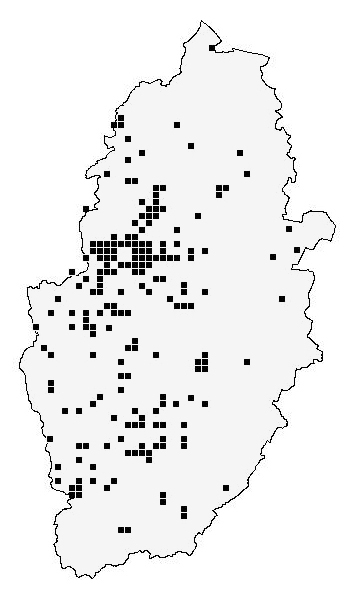 |
|
| COLEOPTERA - CUCUJOIDEA - COCCINELLIDAE - COCCINELLINAE - Calvia | COLEOPTERA - CUCUJOIDEA - COCCINELLIDAE - COCCINELLINAE - Halyzia | |
| Calvia quattuordecimguttata | Halyzia sedecimguttata | |
| Nottinghamshire distribution: Widespread and common over much of Nottinghamshire. The Cream-spot Ladybird is most often found in woodlands and other well vegetated sites, but will occur in suburban gardens. There are few records from the far north of the county, despite the fact that this species will occur on even isolated Pines. | Nottinghamshire distribution: More widespread in the north of Nottinghamshire, but the Orange Ladybird is common in many areas of suburban Nottingham. Another arboreal species, often favouring Beech and Sycamore, there may be some evidence to show it has declined in recent years, but like many other species, is perhaps just as likely to go through periods of much greater abundance. Best looked for on Sycamores which are heavily infested with aphids. | |
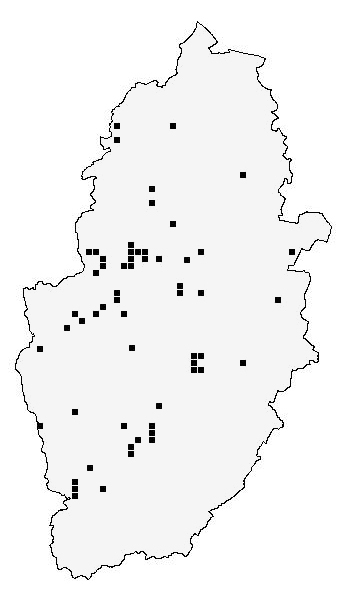 |
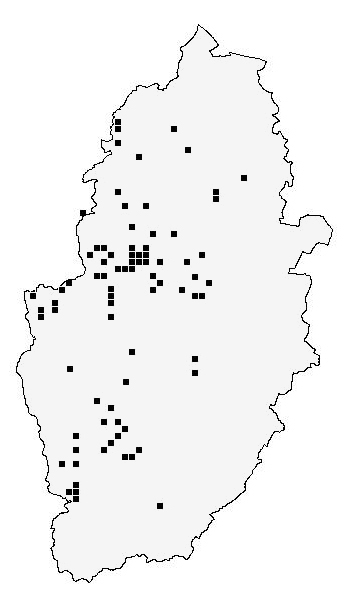 |
|
| COLEOPTERA - CUCUJOIDEA - COCCINELLIDAE - COCCINELLINAE - Psyllobora | COLEOPTERA - CUCUJOIDEA - COCCINELLIDAE - COCCINELLINAE - Anatis | |
| Psyllobora vigintiduopunctata | Anatis ocellata | |
| Nottinghamshire distribution: The bright yellow elytral colouration of the 22-spot Ladybird is diagnostic, but it can be easily missed through its small size. Found in a range of habitats, from woods and hedgerows, to brownfield sites, where it is found on low vegetation covered in Mildew. Probably very much under recorded in Nottinghamshire. | Nottinghamshire distribution: Most Nottinghamshire records of the Eyed Ladybird, come from the Sherwood Forest area and it becomes more uncommon away from Pine forested areas of the county. It does sometimes turn up in more unusual locations, including on a window in Mapperley in 2014. | |
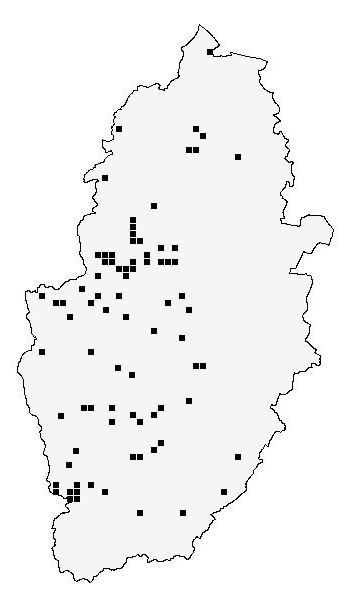 |
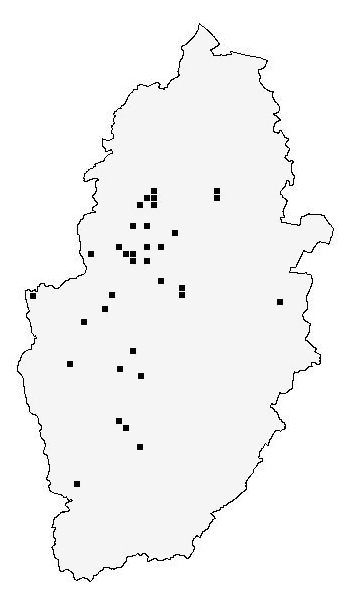 |
|
| COLEOPTERA - CUCUJOIDEA - COCCINELLIDAE - COCCINELLINAE - Aphidecta | COLEOPTERA - CUCUJOIDEA - COCCINELLIDAE - COCCINELLINAE - Hippodamia | |
| Aphidecta obliterata | Hippodamia variegata | |
| Nottinghamshire
distribution:
The Larch Ladybird is one of our
rarest ladybirds, although there may be an element of under recording.
The only Nottinghamshire records, have come from Sherwood Forest, where it was recorded from Proteus Square in 2000 (Drane, T), Clumber Park in 2006 (recorder unknown), Seymour Grove/Budby South Forest in 2010 (Pendleton, T.A. and Pendleton, D.T.) when two were beaten from the lower branches of Larch, Haywood Oaks in 2015 (Pendleton, T.A. and Pendleton, D.T.) and most recently from Sherwood Pines in 2019 (Golding, G.). |
Nottinghamshire distribution: In Nottinghamshire, the Adonis Ladybird shows a preference for sites lying on sandy soils and it can be quite numerous in the Mansfield area. There are several records from the south-west of the county and it seems to have increased its range since 2000. It should be expected to occur on former Colliery spoil heaps and other sparsely vegetated brownfield sites. | |
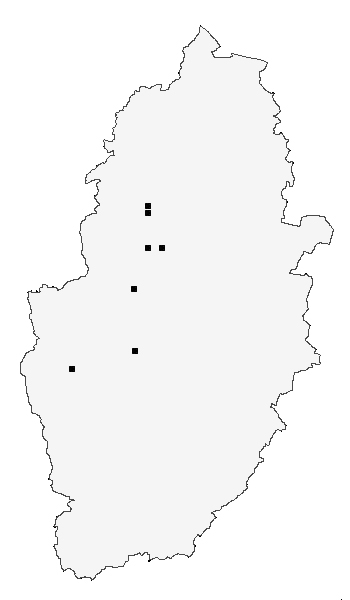 |
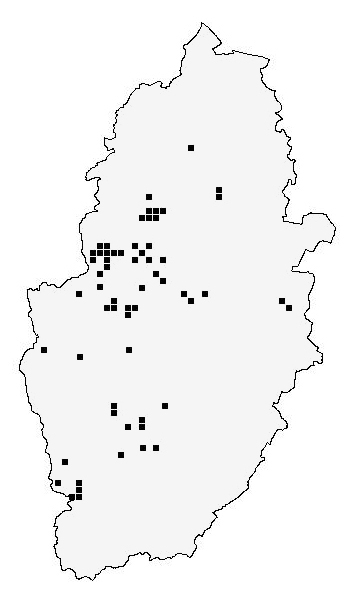 |
|
| COLEOPTERA - CUCUJOIDEA - COCCINELLIDAE - COCCINELLINAE - Coccinella | COLEOPTERA - CUCUJOIDEA - COCCINELLIDAE - COCCINELLINAE - Coccinella | |
| Coccinella hieroglyphica | Coccinella septempunctata | |
| Nottinghamshire distribution: This is a rare Nottinghamshire Ladybird and currently restricted to a handful of wet heath sites in the Sherwood Forest area. In the 1980's, there were records of the Hieroglyphic Ladybird from Clumber Park in 1981, Clipstone Heath in 1987 and Budby South Forest in 1989 (NBN Gateway). However, more recent records have come from the Nottinghamshire Wildlife Trust's reserve at Rainworth Heath in 2007 and 2011 (Williams, H.) and 2014 (Pendleton, T.A. and Pendleton, D.T.). | Nottinghamshire distribution: The 7-spot Ladybird is the most widespread and commonest of all the Nottinghamshire Ladybirds. It is found in any habitat type and its distribution probably only mirrors that of where regular recorders of Coleoptera live. | |
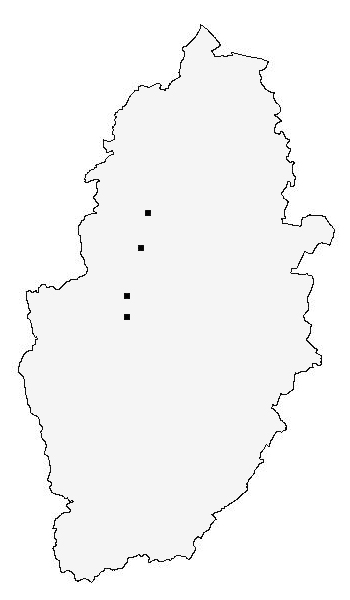 |
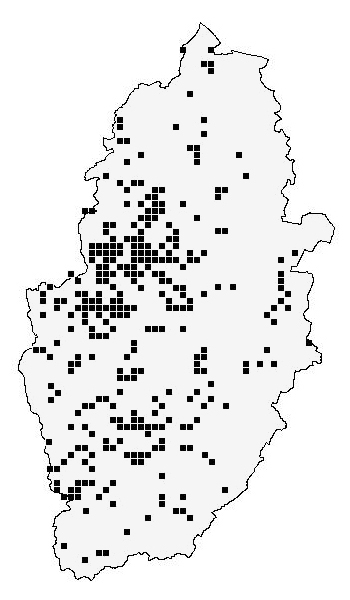 |
|
| COLEOPTERA - CUCUJOIDEA - COCCINELLIDAE - COCCINELLINAE - Coccinella | COLEOPTERA - CUCUJOIDEA - COCCINELLIDAE - COCCINELLINAE - Adalia | |
| Coccinella undecimpunctata | Adalia bipunctata | |
| Nottinghamshire distribution: All Nottinghamshire records of the 11-spot Ladybird appear to have come post-2000 and this ladybird remains a rare species in the county. There are several records now from Attenborough NR (Rogers, R., Sexton, T. and Wetton, B.) Warsop Main Pit Top in 2006 and 2007 (Pendleton, T.A. and Pendleton, D.T.) and the Idle Valley NR near Retford (Pendleton, T.A. and Pendleton, D.T., and Pickwell, A.), with recent records coming from Langford Lowfields in 2012 (Barnes, C.) Netherfield Lagoons in 2019 (Smith, P. and Tyler, M.) and Vexation Lane, Rufford IN 2021 (Pendleton, T.A.). | Nottinghamshire distribution: Widespread and generally still quite common, although 2-spot Ladybird numbers can vary and it can seemingly 'go missing' in poor years. Groups have been recorded passing the Winter under loose bark along the edge of woodland, together with Harmonia axyridis (Pendleton, T.A. and Pendleton, D.T.) and the two species can often be found occupying the same trees in urban areas during the Summer. | |
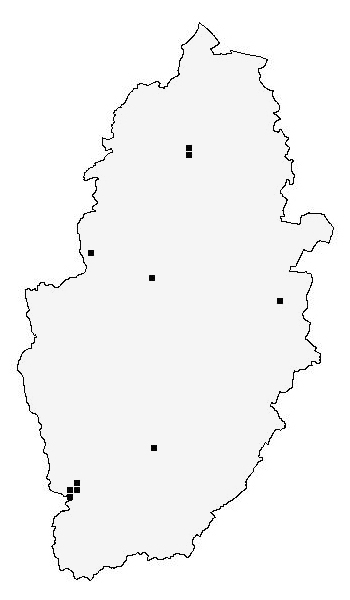 |
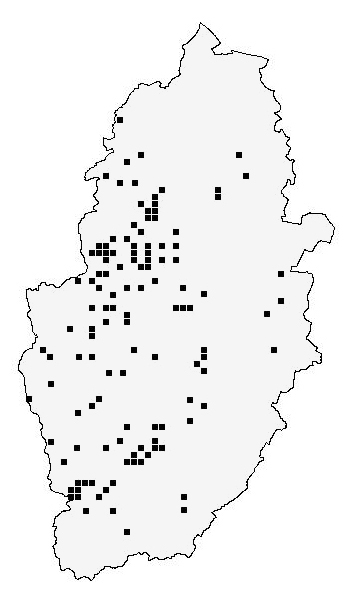 |
|
| COLEOPTERA - CUCUJOIDEA - COCCINELLIDAE - COCCINELLINAE - Adalia | COLEOPTERA - CUCUJOIDEA - COCCINELLIDAE - COCCINELLINAE - Harmonia | |
| Adalia decempunctata | Harmonia axyridis | |
| Nottinghamshire distribution: A common and often indiscreet species, the 10-spot Ladybird has a wide distribution across much of the county and is to be found in a range of habitats. It is regularly found in gardens around both Nottingham and Mansfield, but its generally small size makes it quite difficult to find at well vegetated sites. An extremely variable Ladybird, showing a huge range of variations in both number of spots and ground colouration of the elytra. | Nottinghamshire
distribution: A very common and widespread
species in Nottinghamshire, with huge numbers often seen
in urban areas. It occurs in most types of habitat,
showing a preference for Lime and Sycamore. Originally a Ladybird of Asian origin, the Harlequin Ladybird first appeared in the UK in 2004. Nottinghamshire's first record was from Penny Pasture Common near Eakring in 2006 (Pendleton, T.A. and Pendleton, D.T.) although it had certainly reached Nottinghamshire by 2005. |
|
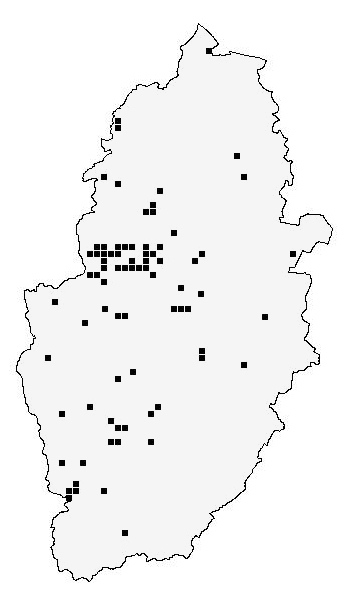 |
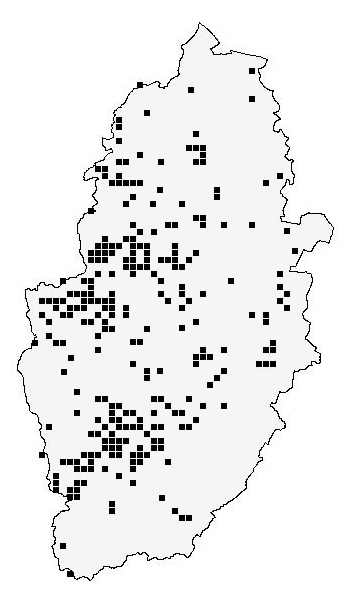 |
|
| COLEOPTERA - CUCUJOIDEA - COCCINELLIDAE - COCCINELLINAE - Harmonia | COLEOPTERA - CUCUJOIDEA - COCCINELLIDAE - EPILACHNINAE - Subcoccinella | |
| Harmonia quadripunctata | Subcoccinella vigintiquattuorpunctata | |
| Nottinghamshire distribution: In Nottinghamshire, the Cream-streaked Ladybird is largely confined to the Sherwood Forest area and is unusual away from there. Usually found on or near Pines, it can be common in areas of commercial forestry. | Nottinghamshire distribution: A scarce species in Nottinghamshire, with all records previously coming from the south of the county at Attenborough NR and Netherfield Lagoons. In 2014, it was found at Besthorpe near Newark, but generally remains confined to the Trent Valley but has now appeared at other Nottinghamshire sites. | |
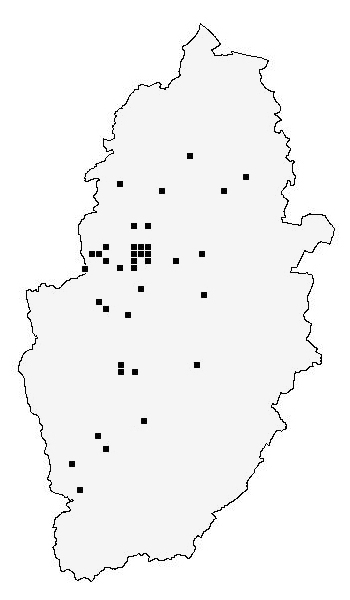 |
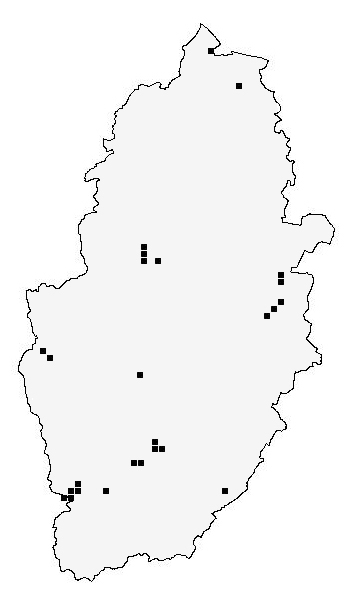 |
|
| Nottinghamshire Ladybirds |
| Homepage |